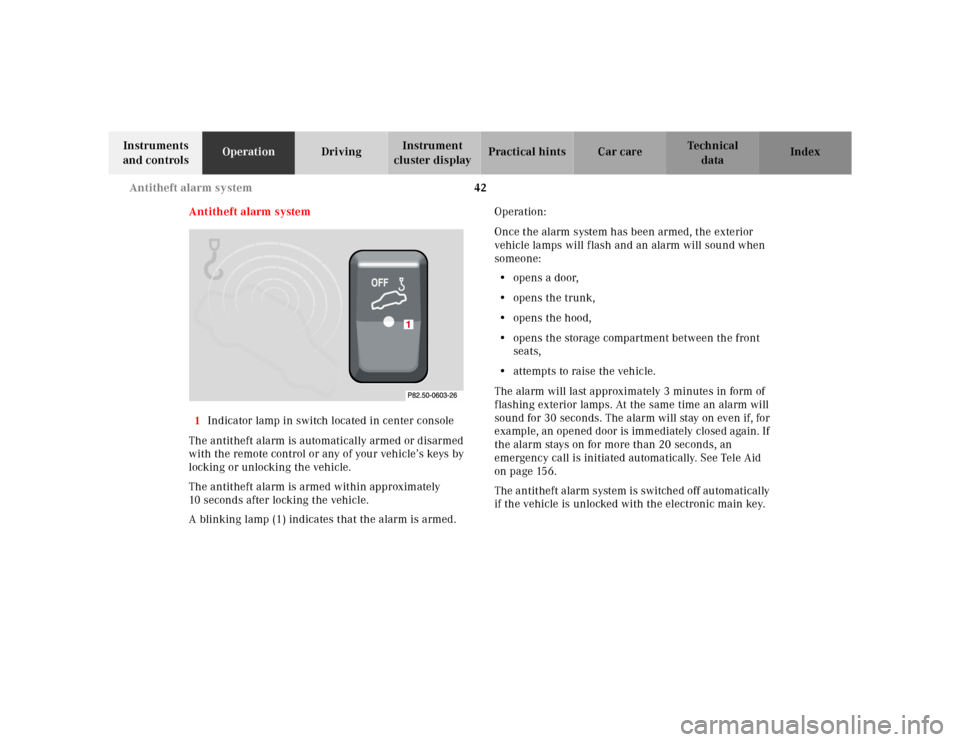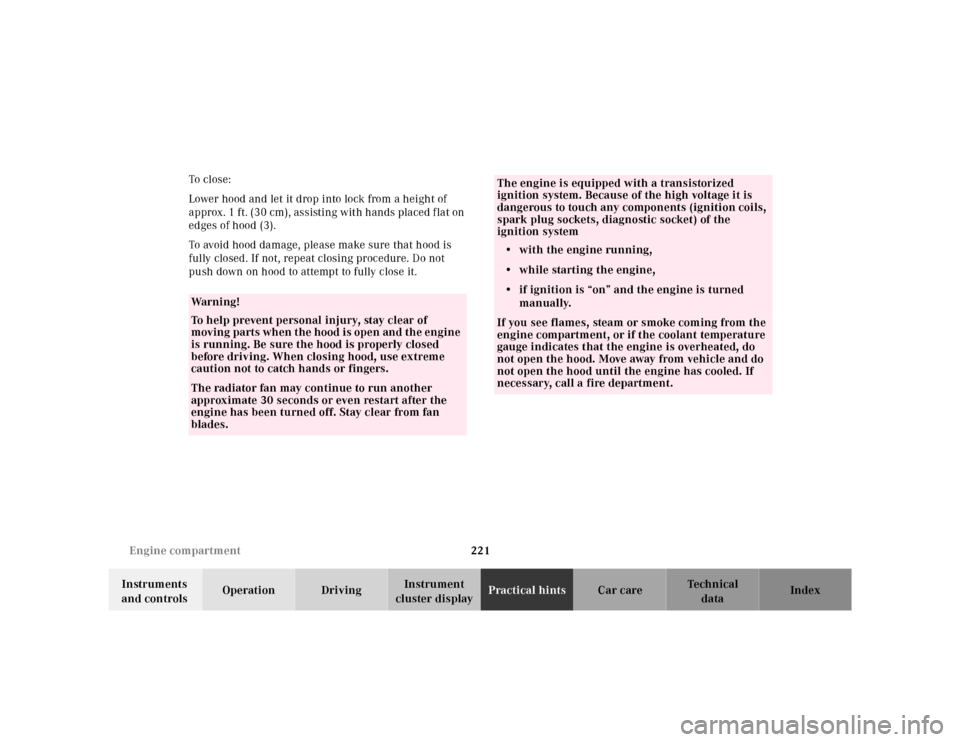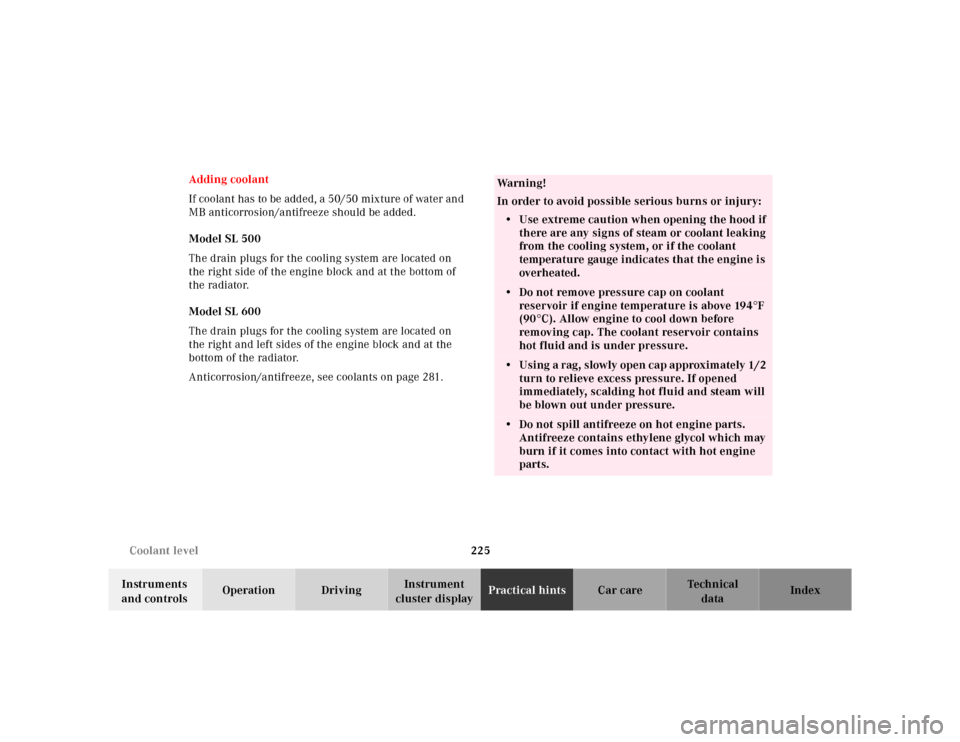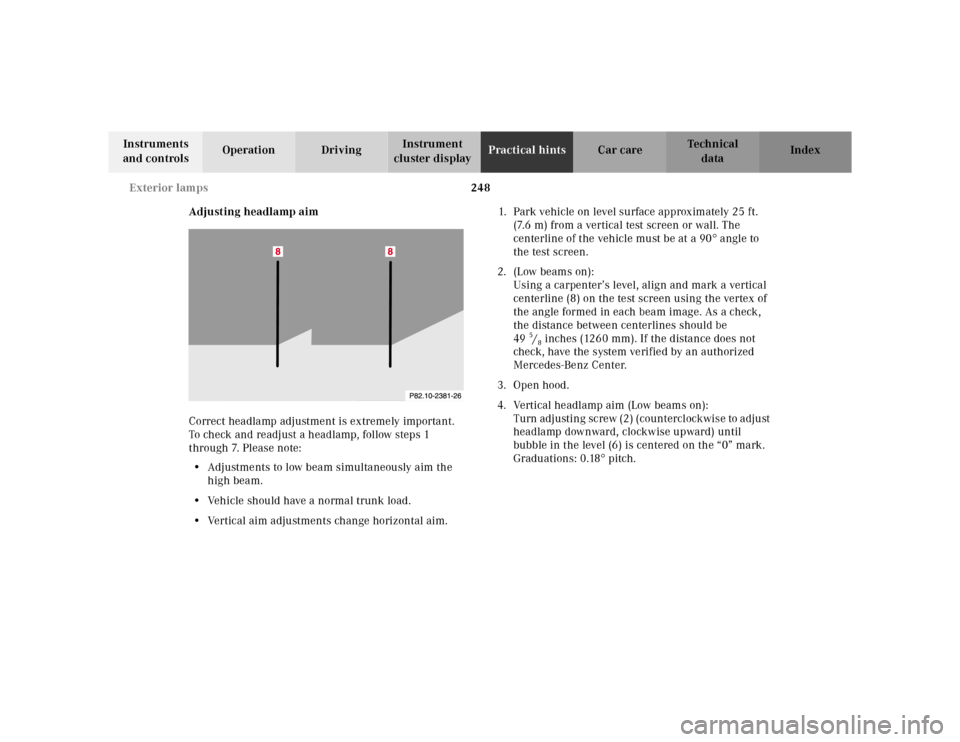Page 46 of 302

42 Antitheft alarm system
Te ch n ica l
data Instruments
and controlsOperationDrivingInstrument
cluster displayPractical hints Car care Index
Antitheft alarm system
1Indicator lamp in switch located in center console
The antitheft alarm is automatically armed or disarmed
with the remote control or any of your vehicle’s keys by
locking or unlocking the vehicle.
The antitheft alarm is armed within approximately
10 seconds after locking the vehicle.
A blinking lamp (1) indicates that the alarm is armed.Operation:
Once the alarm system has been armed, the exterior
vehicle lamps will flash and an alarm will sound when
someone:
• opens a door,
• opens the trunk,
•opens the hood,
• opens the storage compartment between the front
seats,
• attempts to raise the vehicle.
The alarm will last approximately 3 minutes in form of
flashing exterior lamps. At the same time an alarm will
sound for 30 seconds. The alarm will stay on even if, for
example, an opened door is immediately closed again. If
the alarm stays on for more than 20 seconds, an
emergency call is initiated automatically. See Tele Aid
on page 156.
The antitheft alarm system is switched off automatically
if the vehicle is unlocked with the electronic main key.
Page 82 of 302

78 Instrument cluster
Te ch n ica l
data Instruments
and controlsOperationDrivingInstrument
cluster displayPractical hints Car care Index
Coolant temperature gauge
During severe operating conditions and stop-and-go city
traffic, the coolant temperature may rise close to the red
marking.
The engine should not be operated with the coolant
temperature in the red zone. Doing so may cause
serious engine damage which is not covered by the
Mercedes-Benz Limited Warranty.Outside temperature indicator
The temperature sensor is located in the front bumper
area. Due to its location, the sensor can be affected by
road or engine heat during idling or slow driving. This
means that the accuracy of the displayed temperature
can only be verified by comparison to a thermometer
placed next to the sensor, not by comparison to external
displays (e.g. bank signs etc.).
Adaptation to ambient temperature takes place in steps
and depends on the prevailing driving conditions (stop-
and-go or moderate, constant driving) and amount of
temperature change.
Wa r n i n g !
• Driving when your engine is badly overheated
can cause some fluids which may have leaked
into the engine compartment to catch fire. You
could be seriously burned.• Steam from an overheated engine can cause
serious burns and can occur just by opening
the engine hood. Stay away from the engine if
you see or hear steam coming from it.Turn off the engine, get out of the vehicle and do
not stand near the vehicle until it cools down.
Wa r n i n g !
The outside temperature indicator is not designed
to serve as an Ice-Warning Device and is therefore
unsuitable for that purpose. Indicated
temperatures just above the freezing point do not
guarantee that the road surface is free of ice.
Page 206 of 302
202 Check regularly and before a long trip
Te ch n ica l
data Instruments
and controlsOperationDrivingInstrument
cluster displayPractical hints Car care Index
Check regularly and before a long trip 1Coolant level
See “Adding coolant” on page 224.
2Windshield washer and
headlamp cleaning system
For refilling reservoir see page 226.
3Engine oil level
See “Checking engine oil level” on page 222 and
“Engine oil level indicator” on page 82.
4Brake fluid
See “Brake fluid” on page 279.
Opening hood, see page 220.
Ve h i c l e l i g h t i n g : Check function and cleanliness. For
replacement of light bulbs, see “Exterior lamps” on page
243.
Exterior lamp switch, see page 84.
Page 224 of 302
220 Engine compartment
Te ch n ica l
data Instruments
and controlsOperation DrivingInstrument
cluster displayPractical hintsCar care Index
Hood
To o pen :
To unlock the hood, pull release lever under the driver’s
side of the instrument panel.
Pull handle (2) up and open hood.
Caution!
To avoid damage to the windshield wipers or hood, open
the hood only with wipers in the parked position.Pull handle (2) to its stop out of radiator grill, and open
hood (do not pull up on handle).
Note:
Do not lift hood at louvers of grill! Make certain the
windshield wiper arm is not folded forward.
P68.00-0514-26
3
2
3
P88.40-0312-26
Page 225 of 302

221 Engine compartment
Te ch n ica l
data Instruments
and controlsOperation DrivingInstrument
cluster displayPractical hintsCar care Index To cl os e:
Lower hood and let it drop into lock from a height of
approx. 1 ft. (30 cm), assisting with hands placed flat on
edges of hood (3).
To avoid hood damage, please make sure that hood is
fully closed. If not, repeat closing procedure. Do not
push down on hood to attempt to fully close it.
Wa r n i n g !
To help prevent personal injury, stay clear of
moving parts when the hood is open and the engine
is running. Be sure the hood is properly closed
before driving. When closing hood, use extreme
caution not to catch hands or fingers.The radiator fan may continue to run another
approximate 30 seconds or even restart after the
engine has been turned off. Stay clear from fan
blades.
The engine is equipped with a transistorized
ignition system. Because of the high voltage it is
dangerous to touch any components (ignition coils,
spark plug sockets, diagnostic socket) of the
ignition system
• with the engine running,
• while starting the engine,
• if ignition is “on” and the engine is turned
manually.If you see flames, steam or smoke coming from the
engine compartment, or if the coolant temperature
gauge indicates that the engine is overheated, do
not open the hood. Move away from vehicle and do
not open the hood until the engine has cooled. If
necessary, call a fire department.
Page 229 of 302

225 Coolant level
Te ch n ica l
data Instruments
and controlsOperation DrivingInstrument
cluster displayPractical hintsCar care Index Adding coolant
If coolant has to be added, a 50/50 mixture of water and
MB anticorrosion/antifreeze should be added.
Model SL 500
The drain plugs for the cooling system are located on
the right side of the engine block and at the bottom of
the radiator.
Model SL 600
The drain plugs for the cooling system are located on
the right and left sides of the engine block and at the
bottom of the radiator.
Anticorrosion/antifreeze, see coolants on page 281.
Wa r n i n g !
In order to avoid possible serious burns or injury:
• Use extreme caution when opening the hood if
there are any signs of steam or coolant leaking
from the cooling system, or if the coolant
temperature gauge indicates that the engine is
overheated.• Do not remove pressure cap on coolant
reservoir if engine temperature is above 194°F
(90°C). Allow engine to cool down before
removing cap. The coolant reservoir contains
hot fluid and is under pressure.• Using a rag, slowly open cap approximately 1/2
turn to relieve excess pressure. If opened
immediately, scalding hot fluid and steam will
be blown out under pressure.• Do not spill antifreeze on hot engine parts.
Antifreeze contains ethylene glycol which may
burn if it comes into contact with hot engine
parts.
Page 249 of 302
245 Exterior lamps
Te ch n ica l
data Instruments
and controlsOperation DrivingInstrument
cluster displayPractical hintsCar care Index Bulb for high and low beam (Halogen type 9004)
Squeeze latches (4) and remove cover (3) upwards. Pull
off electrical connector (6). Turn clamping ring (7)
counterclockwise and pull out bulb together with
clamping ring. Remove bulb.
Insert new bulb (flat side facing up), mount clamping
ring (7) (with tab facing down) and turn clockwise. Push
electrical connector on securely.Turn signal, parking, side marker and standing
lamp (2357 NA (28.5/8.3 W/30/2.2 cp) (bulb)
Open hood.
Turn bulb socket (5) with bulb counterclockwise and
pull out. Push bulb into socket, turn counterclockwise
and remove.
Insert new bulb in socket, push in and twist clockwise.
Reinstall bulb socket, push in and twist clockwise.
Page 252 of 302

248 Exterior lamps
Te ch n ica l
data Instruments
and controlsOperation DrivingInstrument
cluster displayPractical hintsCar care Index
Adjusting headlamp aim
Correct headlamp adjustment is extremely important.
To check and readjust a headlamp, follow steps 1
through 7. Please note:
• Adjustments to low beam simultaneously aim the
high beam.
• Vehicle should have a normal trunk load.
• Vertical aim adjustments change horizontal aim.1. Park vehicle on level surface approximately 25 ft.
(7.6 m) from a vertical test screen or wall. The
centerline of the vehicle must be at a 90° angle to
the test screen.
2. (Low beams on):
Using a carpenter’s level, align and mark a vertical
centerline (8) on the test screen using the vertex of
the angle formed in each beam image. As a check,
the distance between centerlines should be
49
5/8 inches (1260 mm). If the distance does not
check, have the system verified by an authorized
Mercedes-Benz Center.
3. Open hood.
4. Vertical headlamp aim (Low beams on):
Turn adjusting screw (2) (counterclockwise to adjust
headlamp downward, clockwise upward) until
bubble in the level (6) is centered on the “0” mark.
Graduations: 0.18° pitch.